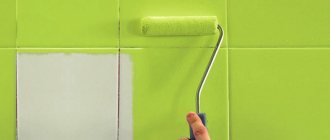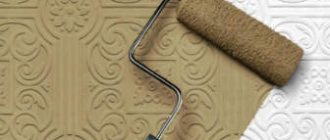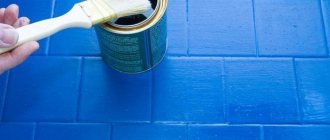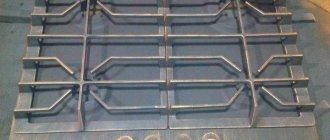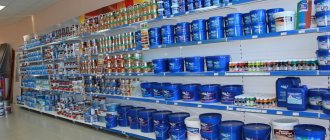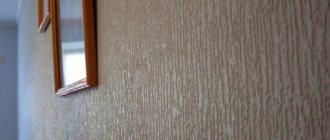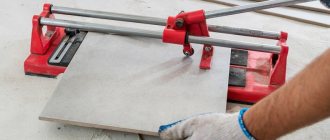Ceramic tiles are the most common covering for walls and floors in a bathroom, toilet or kitchen. It's all about its strength, durability, ability to resist moisture and elevated temperatures - the tile is not afraid of anything and can serve for decades without losing its appearance. But when an apartment is being renovated, you often want to completely change the color scheme of the interior. And this can be done without even removing the tile and replacing it with a new one. How to paint tiles on the floor?
How to paint tiles on the floor
Can tiles be painted?
Can. This unique, durable, moisture-resistant coating can easily be renewed using just this method. At the same time, the ceramic surface is painted very well - the main thing is to choose the right paint and choose the place where it will be applied.
Is it possible to paint tiles on the floor?
On walls, floors and even ceilings, tiles can be safely updated with a fresh coat of paint - there their contact with water will be minimal, and the paint is unlikely to wear off quickly. But it is not recommended to paint tiles located inside showers directly under your feet or directly above the bathtub. The fact is that the durability of the paint and varnish coating, even the highest quality, directly depends on the intensity of exposure to water. And in the shower and above the bathtub, an environment that is too humid for even the highest quality and most reliable paint. In such places, the coating will quickly begin to peel off and all the work will have to be done again. Conclusion - you can safely paint absolutely any tile if it has moderate contact with water.
Painting tiles on a bathroom wall
With the help of paint, the interior of a kitchen or bathroom can be constantly changed as soon as such a desire arises from the owner of the room. Previously, this was exactly how apartment owners got out of the situation; this method of renovating premises was quite common.
On a note! If high-quality paint was used, and all work was carried out strictly according to the rules, then such a coating can last on the tile for up to 30-50 years.
Decor secrets
Using paint you can create an individual design. Drawings with a 3D effect are popular.
How to make a 3D effect
To create a three-dimensional relief, use gauze. Figures of the required size and shape are cut out of it and fixed on the surface of the base. Now the first layer of coloring composition is applied. After it dries, the fabric fragments are treated with enamel of the desired color. For this, a rough roller is used.
Secrets to preserving the durability of a drawing
To preserve the original appearance of the illustration, you need to wait for it to dry completely. This will take 3 days. Now the base is coated with a transparent water-based epoxy varnish. Oil-based polyurethane is also suitable. The varnish is applied in several layers. However, when using it, compatibility with the main finishing material is checked.
Examples in the interior
Today you can choose many options for painting ceramic tiles in the kitchen. The design of each tile fragment in two contrasting colors looks good. One of them may be white. The opposite corners are painted over.
If a drawing is supposed to be on the wall, then it is placed around the entire perimeter or an emphasis is placed on a certain part of the wall. You can also decorate individual tile fragments. A floral or geometric continuous pattern is often applied along the perimeter.
Decorating tiles with paint is the best option if there is no desire or need to completely change the ceramic layer. Anyone can cope with the procedure, even those without artistic talent. You just need to choose a design option, a suitable composition and follow the application technology.
Why paint tiles?
Many people wonder why even take on this labor-intensive job and paint the tiles? It's actually simple. As mentioned above, ceramic surfaces were previously updated using this method, because previously interesting building materials on the market were not as abundant as they are now. And it’s cheaper to simply paint the tiles than to completely dismantle them and glue new ones. It is worth agreeing that much less labor will be required to paint the tiles than to remove the old ceramic coating.
Painting ceramic tiles
The relevance of this method has not disappeared to this day. Sometimes there is neither time nor extra money to completely replace the tiles, and then paint comes to the rescue. Moreover, now there are very high quality and reliable paint coatings, even waterproof, which are perfect for quickly and at minimal cost completely changing the color of the tile. This is especially true for young families who have just bought an apartment. There is not much money in the family budget, but you need to move into a new home now. And the best assistant in updating the interior is paint.
Cosmetic update of tiles
Tile in the bathroom relatively quickly loses its appearance due to high humidity, constant temperature changes, impacts and scratches. Replacing tiles with new ones is a labor-intensive and expensive process. It is impossible for a non-professional to produce it independently. The solution is to update the existing coverage.
Designers widely use the combination of tiles and paint in the bathroom, using the contrast of smooth and textured surfaces, giving the tiles a stylish, bright look.
What paint should I paint the tiles with?
Different paints can be used to paint tiles. And in order to better understand which one to choose, you should familiarize yourself with the different types of paints and varnishes used for finishing in modern renovations.
Choosing paint for tiles
Table. Types of paints used for painting work.
| Type of paint | a brief description of |
| Water-dispersed | These paints are among the cheapest and most unstable to external influences. They are also called “water-soluble”, “water-emulsion”. The thing is that the best solvent for them is ordinary water. Such paints are not used in bathrooms, kitchens and restrooms, as the coating will quickly wear out and lose its appearance under the influence of high air humidity and temperature changes. The only advantage of such paints is that they do not emit an unpleasant odor during application and dry quickly. There are paints based on PVA, acrylic and latex. |
| Silicone | The paint is made on the basis of silicone resins. It entered the market relatively recently, but has already won the love of many craftsmen. Such paints have a high level of vapor permeability and are successfully used to decorate building facades. |
| Oily | The paint is created on the basis of artificial or natural oils. The service life of coatings created with this material is maximum, and the paint is not picky in its use. The disadvantages of the material include low vapor permeability and a long drying time, which is why such paint often peels off or the bottom layer underneath it peels off. Paint is rarely used to decorate apartments and private houses. |
| Alkyd | Manufactured on the basis of alkyd resins. It dries far differently than usual - not due to the rapid evaporation of the solvent in it, but due to the oxidation reaction of the material in air. Thanks to this, the surface layer of paint is very durable and capable of protecting the processed materials from corrosion. |
| Decorative | This is a separate category of paints designed to give surfaces a special look. Such paint can imitate various other materials - wood, fabric, stone, etc. Decorative paints can be made based on water with the addition of various polymers and minerals. |
| Epoxy | It is created on the basis of ordinary epoxy resin, due to which it is a very resistant composition to external influences. This is truly one of the most durable paints currently available on the construction market. It is not afraid of water, does not wear out over a long period of time, and is often used specifically for painting floors in the house. It can even be used in parking lots, in production workshops, and on staircases. |
Different types of paints can be used to paint tiles. For example, water-dispersion paint based on latex performed well in this work. This material is intended for use in damp areas. Oil paints and alkyd paints are also often used.
Paint in cans
On a note! Coatings obtained by working with oil paints will be so durable that they will not even require additional protection of the painted surface - they do not need to be varnished.
To paint walls that are not particularly in contact with water, you can even use acrylic paints, although they are water-soluble. But for decorating and decorating the floor, it is recommended to purchase compounds that are resistant to water and temperatures, otherwise the work will soon have to be redone. Still, there is nothing better for a floor than a well-applied layer of oil paint. The main thing is to let it dry thoroughly before using it.
The simplest tile that can be given any color
Epoxy-based paints also performed well in the process of painting and using painted tiles. Or you can use latex paints to decorate the tiles. In any case, it is important to carefully read the instructions for use on the packaging and make sure that this composition is suitable for application to the floor, and especially to tiles.
On a note! When decorating tiles in the bathroom, you can use paint to give free rein to your imagination and draw patterns. For this purpose, stencils and car paints produced in cylinders are often used. This paint is expensive, but it adheres well to the base even in extreme conditions.
The tiles will need regular cleaning
If you have any doubts about which paint to buy, it is better to opt for special compositions designed for painting tiles or glass. Such paints are available for sale in hardware stores. You can also opt for acrylate-latex paint from Samtex or Tikkurila. A good paint, suitable for painting tiled floor surfaces, should be resistant to abrasion and not afraid of moisture, because wet cleaning has not been canceled.
Suitable paint types
When applying regular paint, after a while the coating will begin to peel and flake off. There are several types of tile paint that are mainly used to update old coatings:
- Latex - has excellent adhesive properties. For dry rooms, you should choose acrylic-latex compounds; for waterproofing purposes, rubber paints are suitable. The coating has a high level of wear resistance and waterproofing, is odorless and absolutely harmless to health.
- Epoxy is a more expensive option. Good adhesion, waterproof. The paint is firmly bonded to the coating and does not peel off over time.
- Oil-based is also suitable, but requires the application of a primer.
- Alkyd enamels have good adhesion and are used only in dry rooms.
- Stained glass for glass and tiles - applied to a smooth, cleaned surface, without preliminary preparation. Having a high cost, it is used mainly for decorative purposes to create a beautiful design.
- Polyurethane – resistant to temperature changes and humidity, does not peel off and is wear-resistant.
The primer for applying epoxy and polyurethane enamels must be based on organic solvents. Water-based primer is not suitable in this case.
In the video: using stained glass paints to cover tiles.
What color should I paint the tiles?
The key to comfort in an apartment is a harmonious combination of all interior elements and impeccable finishing. But there is never a guarantee that one or another design option will look as planned. It is recommended to refrain from the desire to paint the tiles in a bright color, because if it does not look very neat after the work is completed, then the emphasis on it will certainly not be needed .
The best option is a gentle neutral color that blends with the walls. If any mistakes are made while painting the tiles, they will be less noticeable in this case.
Floor tile painting process
Sometimes creative individuals and people who love bright accents paint tiles in several colors at once. In this case, it is easiest to apply the paint using templates or stencils to avoid mistakes and to avoid staining the already applied layer.
Important! If several colors are used when painting tiles, they should be in harmony with each other and match the shades with the interior elements. Only then will the pattern look like an original panel, and not like a tacky daub.
To paint large areas, it is recommended to use regular white paint, adding colors to it. This will save money.
Composition selection
Before painting ceramics, you need to choose the right composition. The following types of paints are used to decorate bathroom walls:
- Acrylic. These are the optimal compositions for ceramic tiles. They are not afraid of exposure to moisture, do not wash out, and are harmless to human health, as they do not contain toxic substances. Such products contain antiseptic components, so fungus and mold do not develop in the bathroom. Acrylic paint comes in different colors, glossy and matte.
- Oily. This is a cheap finishing option that can be applied using a sprayer, brush or roller. It takes more than a day for the layer to dry. Oil paint is rarely used to decorate a bathroom. Despite the color variety, such products are not resistant to moisture and will crack over time. The surface should not be washed with soda solution.
- Alkyd. Such compositions dry quickly, do not crack, and are cheap. They are moisture resistant, give a matte or glossy surface, and are not damaged when exposed to detergents. The layer after application performs a decorative function for 4 years and is not afraid of temperature changes. By adding rosin, the product is used to color floor tiles.
- Epoxy . Of all the bathroom paints, they are characterized by maximum durability and are not afraid of moisture. Decorative qualities last 4-5 years. You can wash the surface using any means.
In addition to these compositions, silicone, silicate and latex paints are used for finishing tiles. The first option does not lose its properties when exposed to moisture and does not have a pungent odor. Silicate compounds repel water and do not become dirty, but their color palette is not rich. Silicone paints are vapor permeable, are not afraid of temperature changes, and are able to hide small surface defects due to the elasticity of the coating.
Tools for painting tiles
To paint tiles, as well as to carry out other painting work, you will need certain equipment. The list of necessary items may vary depending on the scale of the repair, but in general may include:
- fine-grained sandpaper necessary for sanding surfaces;
- primer mixture, preferably epoxy based;
- paint rollers;
- brushes of various sizes;
- rags that will be needed to quickly remove paint stains;
- tray or other container for pouring paint;
- solvent to remove paint from tools;
- wide masking tape, which will be needed to protect the edges of objects or objects adjacent to the surface to be painted;
- degreaser (can be useful, although it is not necessary);
- paint and varnish, which will be needed directly to perform the work and protect the finished painted layer.
Painting tool
It is recommended to carry out all work in old unnecessary clothes or a painting suit. It is better to wear rubber gloves on your hands, and you can protect your hair with a scarf or cap.
Technology and sequence of work
Renewing old tiles in a bathroom or kitchen does not take as long, of course, than replacing them, but the work is not the easiest. Especially if the tiles have a glazed surface. There are only three stages:
- Preparing the base. This includes cleaning from dirt, deglazing, removing dust and degreasing.
- Application of adhesive primer. Pay special attention to the seams. They can be pre-coated with a brush, then the entire surface can be rolled with a primer using a roller.
Working out the seams when painting tiles in the bathroom is very important - Painting tiles. The paint is applied in two layers. When applying the first layer, it is also better to paint the seams first. Don't take too much composition. It is better to prevent the formation of puddles and drips. Ceramic tile paint is usually thick. Streaks often form and are difficult to remove. It is better to paint three times with a “dry brush”, that is, with a minimum of paint.
If we are talking about painting floor tiles, another step may be required - varnishing. The varnish is taken with increased wear resistance and tolerates high humidity well. Usually - deck or yacht. They can definitely withstand the load. But make sure they are compatible with the tile helmet you choose.
And yet, long-term results are not guaranteed. To check, you can carry out work in a small area “where it is not visible.” True, the materials should already be there... In any case, this way you can work out the technique, and in the process a lot of things become clearer.
Preparing for painting
Work on painting tiles begins with preparing the surface and the room itself. To begin with, it is recommended to clear the room of furniture and interior items that may interfere with the work. It is recommended to cover anything that cannot be removed with plastic wrap to prevent drops of paint from falling onto the surface. While the paint on smooth objects can still be wiped off, the upholstery of the upholstered furniture cannot be saved without dry cleaning.
It is advisable to cover the furniture with film
The surface of the tile itself also needs preparation. If you neglect this stage, the layer of paint and varnish material will quickly begin to peel off and crumble. The surface of the tile is first washed with some cleaning agent. If the tiles are painted in the kitchen, then it is important to remove all grease stains - the paint will not stick to them. You can degrease the surface using a special liquid or use vinegar or an alcohol solution.
Washing ceramic tiles
Then, as soon as the tile is dry, it is carefully sanded with sandpaper - it is necessary to make the surface slightly rough. Only in this case will the paint stick well. If the tiles on the floor are rough in themselves, then you can do without the grinding step.
On a note! Not only the tiles are sanded, but also all the joints between them.
It is also important to inspect all tiles before painting to make sure they are intact. Damaged elements must either be removed and replaced with new ones, or repaired.
Preparatory work
First of all, you need to prepare the following tools:
- hard bristle brush;
- cleaning products;
- primer mixture;
- roller, brushes of different sizes;
- tile paint.
Having decided on the paint for the tiles, you need to do several preparatory work, including:
- Removing splashes, dust and lime deposits from tiles. For this purpose, abrasive powder or an acidic detergent is suitable, which will do an excellent job of removing old dirt.
- Wash off the remaining detergent with a wet cloth, then wait until the surface is completely dry.
- Degreasing tiles with acetone or gasoline.
- Cleaning the surface with sandpaper for better adhesion of paint to a glossy surface.
- Removing dust with a dry cloth or vacuum cleaner.
- Surface primer.
- Sealing seams with putty.
First of all, you need to clean the seams, since this is where the largest amount of dirt accumulates. If improperly cleaned after painting, mold, mildew and other microorganisms may appear in these areas.
The procedure for painting work
Step 1. The floor is thoroughly washed and sanded if necessary. Preliminary preparation of the base for painting is carried out. The baseboards are covered with masking tape to prevent them from being stained by paint.
First you need to wash the floor
Skirting boards covered with masking tape
Step 2. The surface of the tile is cleaned of grease stains. This is especially true for kitchen areas. The liquid can be applied using a long-handled brush. Sometimes you have to perform the procedure more than once. It is very important to handle all corners well. Next, the floors are washed with clean water and dried well. It is also recommended to apply a layer of primer to the tiles before painting.
Degreasing the tile surface
Step 3. It's time to apply the paint. It should be distributed evenly over the entire surface. For convenience, it is recommended to use a roller with a long handle. The paint is poured into a paint tray - this makes it easier to wet the roller in it. It is recommended to stir the paint well before use. The material is applied in several layers, and the smoother the surface of the tile, the more layers will be required (up to 3-4). The layers are applied in stages, each after the previous one has dried. Coloring begins from the corner farthest from the exit.
Applying paint with a long-handled roller
Painting floor tiles
Step 4. The corners in the room are well processed.
Particular attention should be paid to the corners of the room
Step 5. After the paint has been applied to the surface, it should dry well. About a day is enough for the first layer, then a second layer can be applied. Next, the waiting time until a new coat of paint is applied is about 6-12 hours, depending on the composition used.
Applying paint to tiles
Step 6: After applying the final coat of paint, you must wait at least 72 hours before the floor can be walked on. This period is necessary for all layers of paint to dry thoroughly.
In this example, the tiles are also painted on the walls.
Video - How to paint tiles
Video – Updating old tiles
Prices for Tarkett floor tiles
Tarquette floor tiles
What problems does painting tiles solve?
Tile finishing is a practical and long-term solution, but even such a surface needs to be refreshed from time to time. Owners decide to paint for the following reasons:
- The method allows you to easily and quickly update a boring or outdated design. At the same time, the surface is restored: scratches, chips and small cracks are masked.
- The method requires small financial investments. All you need is to purchase paints and varnishes and the simplest tools.
- Completion times and labor costs will also be minimal. Dismantling of plumbing is not necessary; It is enough to protect the bathtub, sink, taps, and coils with polyethylene.
- Variety of designs. You can choose any shade and complement it with a pattern made using a stencil.
Using a stencil in floor decoration Source britishceramictile.com
Should I paint ceramic flooring?
You can paint your bathroom floors by choosing a paint with increased resistance to moisture and mechanical stress. But you shouldn’t apply paint to the shower floor; not a single product will withstand the increased flow of water for long.
You can paint your bathroom floors by choosing a paint with increased resistance to moisture and mechanical stress.
Grout
Grout can be applied in two ways.
- If you paint it and the tile the same color, the grout should be flush with the tile. To do this, use a spatula or flat scraper. Remove excess with a rag or sponge.
- The second option is to apply the grout by pressing it into the seam. This method is used when the grout and tiles differ in color. You can press it with a special rounded scraper or just with your finger.
Grout, like paint, has a drying time. Some set completely in high humidity, others like dry air. Consider this before painting tiles or starting to use the bathroom.
Applying the coating with a spatula.
Reviews about paints
According to reviews, the compositions have the following properties:
- Flügger Flutex 10 is a thick matte paint. It has a noticeable smell, not particularly strong. It's easy to apply, doesn't drip, and doesn't require much leveling. The Flutex coating is not bad - applied with a brush. Full coverage can be achieved in just 2-3 coats. Nothing special? The old bathroom disappeared under 5-6 coats of V33 roller painted. Not a bad result.
Photo of a painted wall – matte white - V33 for tiles is a two-component product - the contents must be poured into a container, then mixed thoroughly. The additional component that guarantees the properties of the product turned out to be problematic, so it is necessary - its smell is unpleasant, spicy. V33 is more liquid, it seems that it “flows” along the wall. After applying two coats, the walls looked much better, although they still needed bleaching. Experience, the right tools, and work technique will be decisive!
Photo of a painted wall – satin white with shine
Photo. 3 coats of V33 applied
Photo. V33 Layer Count Comparison
